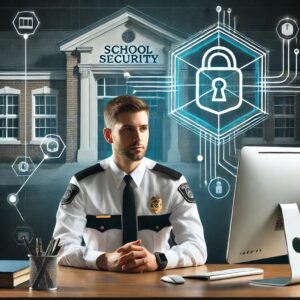
School security has always been a top priority for educators, administrators, and parents alike. However, in today’s interconnected world, the definition of “security” has expanded beyond traditional physical measures like fences, cameras, and patrols. Now, school security must also encompass robust cybersecurity practices to safeguard against the rising threat of digital attacks.
This dual responsibility presents a new challenge: how can schools protect both their physical campuses and the sensitive digital ecosystems that are increasingly integral to modern education? This blog explores the growing overlap between physical security and cybersecurity in schools, offering actionable insights for educators and administrators.
The Importance of Physical Security in Schools
Physical security is the foundation of school safety. Measures like access control systems, on-site security personnel, emergency response protocols, and surveillance cameras ensure that campuses are protected from unauthorized access, vandalism, and potential violence.
However, while physical security systems are highly effective at safeguarding the tangible aspects of a school, they are not enough in isolation. Today’s threats extend far beyond the physical realm, making cybersecurity an equally critical component of a school’s safety strategy.
Why Cybersecurity Matters in Schools
In the digital age, schools are a prime target for cyberattacks. Sensitive information such as student records, staff payroll data, and even lesson plans are stored electronically, making them vulnerable to breaches. Cyber threats like ransomware, phishing, and Distributed Denial of Service (DDoS) attacks can disrupt learning, compromise data, and result in significant financial losses for schools.
According to industry experts like Matt Pasquinilli, a leader in school security consulting, “A school’s network is just as important to secure as its main entrance. Overlooking cybersecurity is like leaving a backdoor unlocked—it invites trouble.”
Bridging the Gap: The Role of Security Professionals
The modern role of school security professionals must integrate both physical and cyber protection. Here’s how schools can address these interconnected challenges:
1. Invest in Cybersecurity Training for Staff
Teachers and administrators are often the first line of defense against cyber threats. Providing regular training on recognizing phishing emails, protecting passwords, and understanding safe internet practices can significantly reduce vulnerabilities.
2. Conduct Regular Risk Assessments
Schools should regularly audit their physical security measures and digital systems. Are doors secure? Are security cameras functioning properly? Is the network protected by firewalls and antivirus software? Conducting holistic risk assessments ensures both physical and cyber weaknesses are addressed.
3. Create Comprehensive Security Policies
Schools should implement clear policies that integrate physical and cyber safety. For example:
• Physical Security Policies: ID badge requirements, visitor check-ins, and regular lockdown drills.
• Cybersecurity Policies: Password rotation, data encryption, and strict access controls for sensitive information.
4. Leverage Technology for Dual Protection
Modern security technologies can address both physical and digital threats. For instance, access control systems can include biometric authentication for staff, while security cameras with AI capabilities can detect unusual behavior. At the same time, robust IT systems can monitor network activity and block unauthorized access.
5. Partner with Experts
Schools should not navigate these challenges alone. Working with school security consultants like Matt Pasquinilli can help schools create customized strategies that address their unique vulnerabilities.
The Benefits of a Holistic Security Strategy
By integrating physical and cybersecurity measures, schools can create a safer environment for students and staff. This dual approach ensures:
• Peace of Mind: Parents, teachers, and students feel more secure knowing their school is prepared for both physical and digital threats.
• Reduced Financial Risk: Proactive cybersecurity measures can save schools from the high costs associated with ransomware attacks and data breaches.
• Uninterrupted Learning: A secure environment minimizes disruptions, allowing students to focus on their education.
Looking Ahead: The Future of School Security
As technology continues to evolve, so will the challenges of school security. Schools must stay ahead by adopting emerging technologies, fostering a culture of security awareness, and continually reassessing their strategies.
In the future, expect to see even greater integration between physical and cybersecurity measures, such as the use of AI-driven threat detection systems, blockchain-based data protection, and advanced emergency communication tools.
By taking a proactive and holistic approach to security, schools can ensure that their campuses—both physical and digital—are safe, resilient, and ready to meet the challenges of tomorrow.
Ready to Strengthen Your School’s Security?
If your school is ready to take the next step in protecting both its physical and digital assets, consult with experts in school security and cybersecurity. A comprehensive strategy is not just an investment in safety; it’s an investment in the future of education.